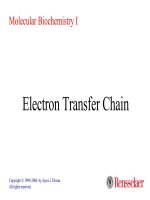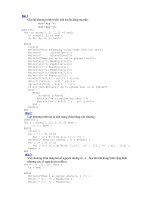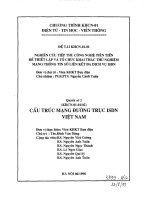Cau truc mang
Bạn đang xem bản rút gọn của tài liệu. Xem và tải ngay bản đầy đủ của tài liệu tại đây (345.09 KB, 39 trang )
Electron Transfer Chain
Copyright © 1999-2006 by Joyce J. Diwan.
All rights reserved.
Molecular Biochemistry I
Electron Transfer
An electron transfer reaction:
A
ox
+ B
red
A
red
+ B
ox
A
ox
is the oxidized form of A (the oxidant)
B
red
is the reduced form of B (the reductant).
For such an electron transfer, one may consider two
half-cell reactions:
A
ox
+ n e
-
A
red
e.g., Fe
+++
+ e
-
Fe
++
B
ox
+ n e
-
B
red
A
ox
+ n e
-
A
red
B
ox
+ n e
-
B
red
For each half reaction:
E = E°' – RT/nF (ln [reduced]/[oxidized])
e.g., for the first half reaction:
E = E°' – RT/nF (ln [A
red
]/[A
ox
])
E = voltage, R = gas const., F = Faraday, n = # of e
−
.
When [A
red
] = [A
ox
], E = E°'.
E°' is the mid-point potential, or standard redox
potential, the potential at which [oxidant] = [reductant]
for the half reaction.
For an electron transfer:
∆E°' = E°'
(oxidant)
– E°'
(reductant)
= E°'
(acceptor)
– E°'
(donor)
∆G
o
' = – nF∆E°'
(E°' is the mid-point potential)
An electron transfer reaction is spontaneous (negative
∆G) if E°' of the donor is more negative than E°' of the
acceptor, i.e., when there is a positive ∆E°'.
Consider transfer of 2 electrons from NADH to oxygen:
a. ½ O
2
+ 2H
+
+ 2e
-
H
2
O
E°' = +0.815 V
b. NAD
+
+ 2H
+
+ 2e
-
NADH + H
+
E°' = −0.315 V
Subtracting reaction b from a:
c. ½ O
2
+ NADH + H
+
H
2
O + NAD
+
∆E°'= +1.13 V
∆G = − nF∆E
o
' = – 2(96494)(1.13) = – 218 kJ/mol
Electron Carriers
NAD
+
/NADH and FAD/FADH
2
were introduced
earlier.
FMN (Flavin MonoNucleotide) is a prosthetic group
of some flavoproteins.
It is similar in structure to FAD (Flavin Adenine
Dinucleotide), but lacking the adenine nucleotide.
FMN (like FAD) can accept 2 e
-
+ 2 H
+
to form
FMNH
2
.
FMN, when bound at the active site of some enzymes, can
accept 1 e
−
to form the half-reduced semiquinone radical.
The semiquinone can accept a 2
nd
e
−
to yield FMNH
2
.
Since it can accept/donate 1 or 2 e
−
, FMN has an important
role mediating e
−
transfer between carriers that transfer 2e
−
(e.g., NADH) & those that can accept only 1e
−
(e.g., Fe
+++
).
C
C
C
H
C
C
H
C
N
C
C
N
N
C
NH
C
H
3
C
H
3
C
O
O
CH
2
HC
HC
HC
H
2
C
OH
O P O-
O
O-
OH
OH
C
C
C
H
C
C
H
C
N
C
C
H
N
N
C
NH
C
H
3
C
H
3
C
O
O
CH
2
HC
HC
HC
H
2
C
OH
O P O-
O
O-
OH
OH
C
C
C
H
C
C
H
C
N
C
C
H
N
N
H
C
NH
C
H
3
C
H
3
C
O
O
CH
2
HC
HC
HC
H
2
C
OH
O P O-
O
O-
OH
OH
e
−
+
H
+
e
−
+
H
+
FMN
FMNH
2
FMNH
·
Coenzyme Q (CoQ, Q, ubiquinone) is very hydrophobic.
It dissolves in the hydrocarbon core of a membrane.
It includes a long isoprenoid tail, with multiple units having
a carbon skeleton comparable to that of isoprene.
In human cells, most often n = 10.
Q
10
’s isoprenoid tail is longer than the width of a bilayer.
It may be folded to yield a more compact structure, & is
postulated to reside in the central domain of a membrane,
between the 2 lipid monolayers.
O
O
CH
3
O
CH
3
CH
3
O
(CH
2
CH C CH
2
)
n
H
CH
3
coenzyme Q
isoprene
H
2
C
C C
CH
2
CH
3
H
The quinone ring of
coenzyme Q can be
reduced to the quinol
in a 2e
−
reaction:
O
O
CH
3
O
CH
3
CH
3
O
(CH
2
CH C CH
2
)
n
H
CH
3
OH
OH
CH
3
O
CH
3
CH
3
O
(CH
2
CH C CH
2
)
n
H
CH
3
2
e
−
+ 2
H
+
coenzyme Q
coenzyme QH
2
Q + 2 e
−
+ 2 H
+
QH
2
.
When bound to special sites in respiratory complexes, CoQ
can accept 1 e
−
to form a semiquinone radical (Q·
−
).
Thus CoQ, like FMN, can mediate between 1 e
−
& 2 e
−
donors/acceptors.
O
O
CH
3
O
CH
3
CH
3
O
(CH
2
CH C CH
2
)
n
H
CH
3
OH
OH
CH
3
O
CH
3
CH
3
O
(CH
2
CH C CH
2
)
n
H
CH
3
e
−
+ 2
H
+
coenzyme Q
coenzyme QH
2
O
−
O
CH
3
O
CH
3
CH
3
O
(CH
2
CH C CH
2
)
n
H
CH
3
e
−
coenzyme Q
•
−
Coenzyme Q functions as a mobile e
−
carrier within
the mitochondrial inner membrane.
Its role in trans-membrane H
+
transport coupled to e
−
transfer (Q Cycle) will be discussed later.
Heme is a prosthetic group of cytochromes.
Heme contains an iron atom in a porphyrin ring system.
The Fe is bonded to 4 N atoms of the porphyrin ring.
N
N
N
N
CH
3
HC
CH
3
S CH
2
CH
3
CH S CH
2
CH
3
CH
2
CH
2
COO
−
CH
3
H
3
C
CH
2
CH
2
−
OOC
protein
protein
Fe
Heme c
Hemes in the 3 classes of cytochrome (a, b, c) differ slightly in
substituents on the porphyrin ring system. A common feature is
2 propionate side-chains. Only heme c is covalently linked to
the protein via thioether bonds to cysteine residues.
N
N
N
N
CH
3
HC
CH
3
S CH
2
CH
3
CH S CH
2
CH
3
CH
2
CH
2
COO
−
CH
3
H
3
C
CH
2
CH
2
−
OOC
protein
protein
Fe
Heme c
Heme a is unique in having a long farnesyl side-chain
that includes 3 isoprenoid units.
N
N
N
N
CH
3
HC
CH
2
CH
3
CH CH
2
CH
2
CH
2
COO
−
CH
3
HC
CH
2
CH
2
−
OOC
Fe
OH
CH
2
CH C CH
2
CH
3
3
H
O
Heme a
The heme iron can undergo a 1 e
−
transition between ferric
and ferrous states: Fe
+++
+ e
−
Fe
++
In the RasMol display of
heme c at right, the
porphyrin ring system is
displayed as ball & sticks,
while Fe is displayed as
spacefill.
Heme in cytochrome c
PDB file 5CYT









